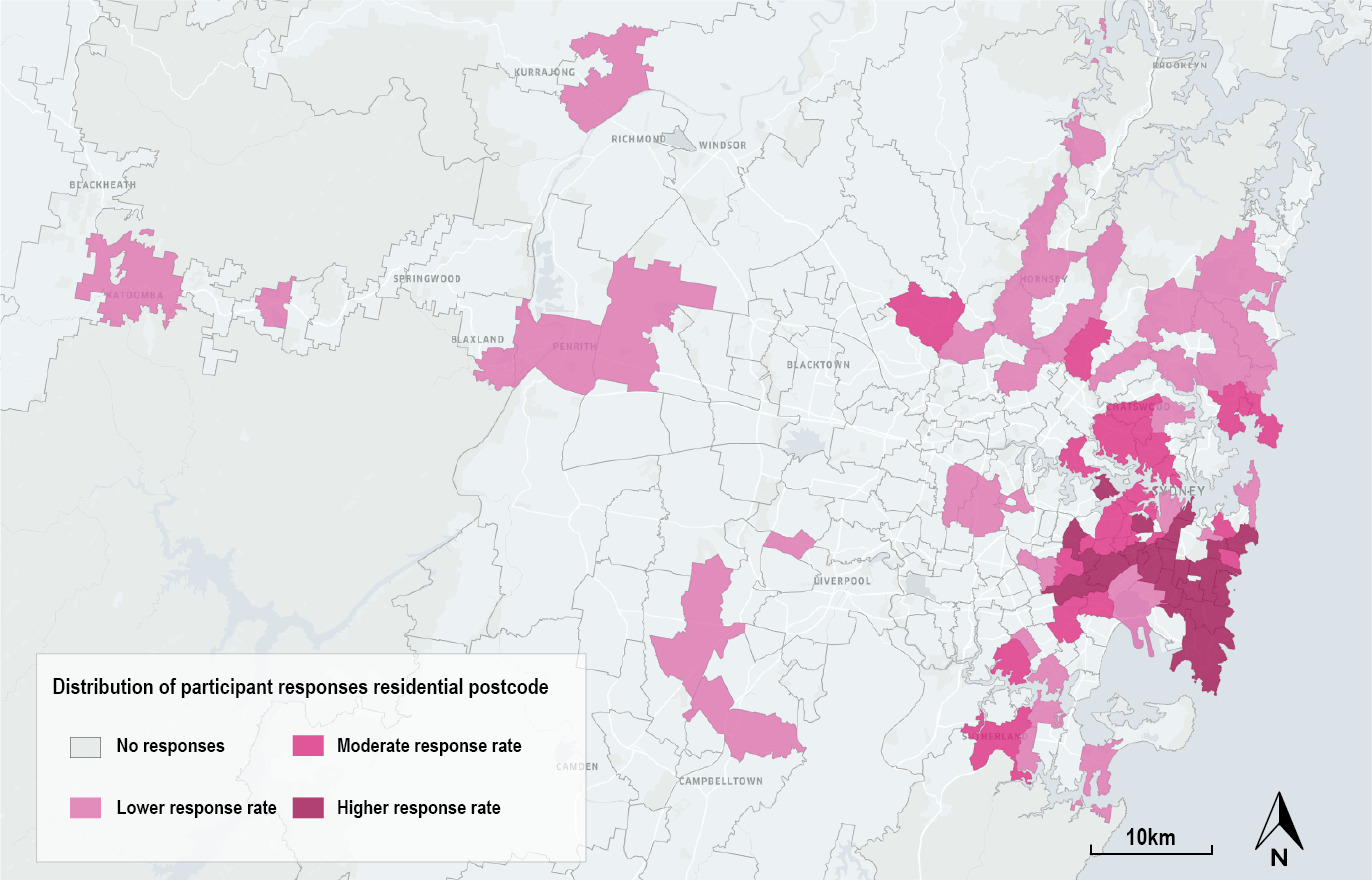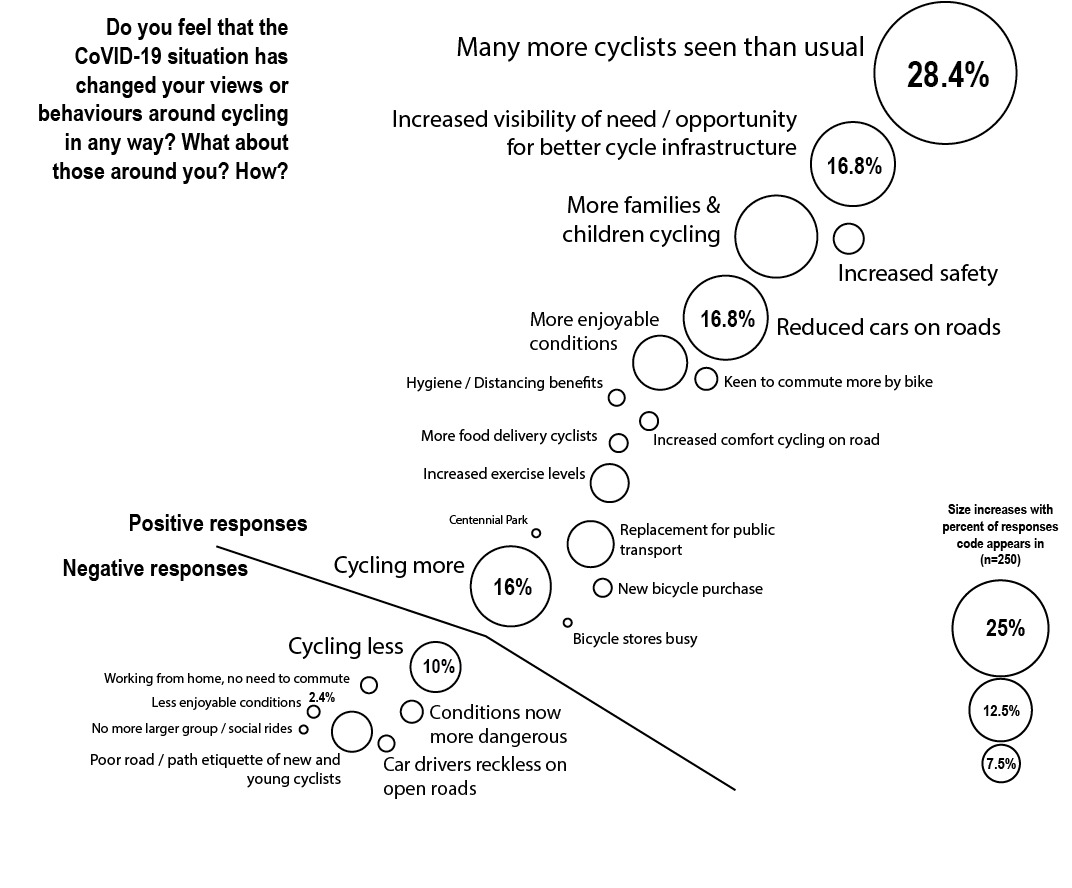1. Research Question[s] and Hypothesis[es]
It has been articulated within the transport professional and research community that there will be widespread changes in the design and use of transport networks as a result of the COVID-19 pandemic - both in direct response to the virus, its prevention in future, higher uptake in remote work and observation of new healthier, more sustainable travel habits.
In the city of Sydney in Australia, social distancing measures heavily reduced the amount of private vehicles on the road, and combined with the temporary closure of indoor exercise facilities, and a need to simply ‘get outside’ by office workers working from home saw potentially new forms of uptake and behaviour regarding urban cycling. Generally, research on cycling in Sydney has identified an enthusiastic population of potential cyclists - in some cases showing latent demand (Rissel et al. 2010), while also coupling this with evidence of barriers to cycling such as limited success in measures such as bikesharing (Heymes 2019) and a need for more separated cycleways (Standen et al. 2017).
It is timely to document the experience of urban cyclists and how they personally perceived their travel habits changed during this time, as well as their experience of others. This research documents the zeitgeist of cyclists in the city Sydney, Australia during a time of government-mandated social distancing restrictions. It asks the research question: "How has cycling behaviour potentially changed as a result of COVID-19?
2. Methods and Data
As part of a wider study on participatory tools for cycle planning, an online survey was sent out an open for two weeks in May 2020. The survey was circulated using the snowball sampling method - starting with the researchers’ own contacts and then shared through various personal, professional and social media channels. The target audience for this was anyone in Sydney, over 18 years of age, who would be interested in undertaking the survey.
This research focuses on the analysis of one question of this survey which received an unprecedented level of detailed responses: ‘Do you feel that the COVID-19 situation has changed your views or behaviours around cycling in any way? What about those around you? How?’ The research closely examines the answers to this question - identifying and summarising common themes, topics and ideas.
3. Findings
The sample for this study achieved 250 responses within a two-week period. Participants were from a diverse geographic range, residing in over 90 different postcodes throughout Sydney, shown in Figure 1. 64.4% of participants identified as male, 34.4% as female and the remainder 1.2% as other gender identities. In terms of age brackets, 5.5% were 18-24, 25% were 25-34 or 45-54, 30% were 35-44 and the remainder were 55 and over. This is in line with other survey results involving cyclists, showing a skew towards middle-aged males for over 18-year-olds (Austroads 2019). Of the 250 responses, there were a total of 4,000 words averaging at approximately 16 words per response. In many examples, participants described in detail what was occurring in their lives.
This research follows a simple method of thematic analysis highlighted by Braun and Clarke (2006). Key codes were derived from reading all individual responses and counting the number of responses which matched these codes in a systematic way. A diagram summarising these codes can be found in Figure 2. In this figure, one can observe the codes from positive themes describing positive changes to participants’ lives and perceptions of cycling (top-right), as well as negative changes (bottom left). From the analysis of these codes, more general themes were derived. Each of these themes, paired with key quotes, can be found summarised in Appendix 1, Table A1.
The key themes identified were that more (and, in many cases, described as ‘new’) cyclists were observed than usual, there was a reduced amount of traffic which influenced this, there was a collective stronger imperative for better cycling infrastructure, there were higher volumes of children and families cycling, new concerns for safety arose (mainly from more inexperienced cyclists sharing infrastructure), there was a general increased willingness to cycle (including new bike purchases) and there were potential changes in commuting behaviour as a result of hygiene reasons and newfound enjoyment in cycling. Through the analysis of these codes, themes and key quotes, this research confirms anecdotal evidence, from a high volume of individuals with a wide geographic spread, of changes in cycling behaviour that occurred during this period.
There are, of course, limitations to consider. Firstly, although the target audience was general, approximately 92% of respondents reported their cycling frequency of at least once a month, with only 8% of respondents reporting infrequent to no cycle use. As such, further work specifically targeting those individuals without any strong past interest in cycling could be undertaken for a more rounded overview (despite evidence of new cyclists in responses). Secondly, this research primarily documents individuals’ self-reporting of their own attitudes and behaviours, and the behaviours of others. While we can document these behaviours, a holistic view on attitudes is less accessible through this research method, only partially insinuated through observations.
As restrictions ease, these findings pose several implications for transport system planners: such as potential increased public support of active transport infrastructure, a potential permanent disruption of regular travel habits and potentially new design guidelines for resilient transport systems. Further, updated transport forecasts feeding infrastructure business cases should consider both the unprecedented potential behaviour change from reduced traffic flow observed, as well as the potential long-term impacts of new cyclists will have on networks.
Further research can observe the extent which these behaviours continue to be carried out in future. This research can also complement findings with other cities of varying typologies which faced similar restrictions during this period. In this vein, it is envisioned that this research will contribute to others’ findings of latent demand for active travel identified during this time, brought about through both quieter and safer road conditions.
Acknowledgments
The author would like to thank the participants for their prompt and detailed responses and for those who shared the survey. The author would also like to thank the reviewers for their timely feedback on improving this article. Additional thanks to the author’s PhD supervisors Christopher Pettit, Simone Zarpelon Leao and Tomasz Bednarz for the support of the wider research behind this.




